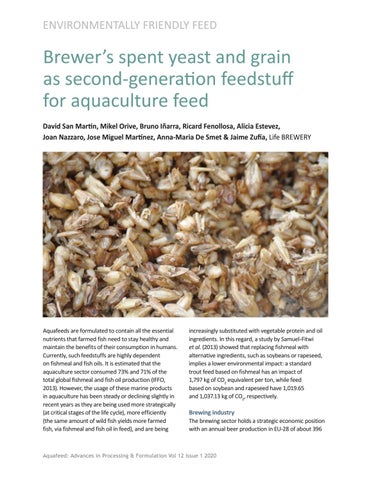ENVIRONMENTALLY FRIENDLY FEED
Brewer’s spent yeast and grain as second-generation feedstuff for aquaculture feed David San Martin, Mikel Orive, Bruno Iñarra, Ricard Fenollosa, Alicia Estevez, Joan Nazzaro, Jose Miguel Martínez, Anna-Maria De Smet & Jaime Zufía, Life BREWERY
Aquafeeds are formulated to contain all the essential nutrients that farmed fish need to stay healthy and maintain the benefits of their consumption in humans. Currently, such feedstuffs are highly dependent on fishmeal and fish oils. It is estimated that the aquaculture sector consumed 73% and 71% of the total global fishmeal and fish oil production (IFFO, 2013). However, the usage of these marine products in aquaculture has been steady or declining slightly in recent years as they are being used more strategically (at critical stages of the life cycle), more efficiently (the same amount of wild fish yields more farmed fish, via fishmeal and fish oil in feed), and are being
increasingly substituted with vegetable protein and oil ingredients. In this regard, a study by Samuel-Fitwi et al. (2013) showed that replacing fishmeal with alternative ingredients, such as soybeans or rapeseed, implies a lower environmental impact: a standard trout feed based on fishmeal has an impact of 1,797 kg of CO2 equivalent per ton, while feed based on soybean and rapeseed have 1,019.65 and 1,037.13 kg of CO2, respectively.
Brewing industry The brewing sector holds a strategic economic position with an annual beer production in EU-28 of about 396
Aquafeed: Advances in Processing & Formulation Vol 12 Issue 1 2020
